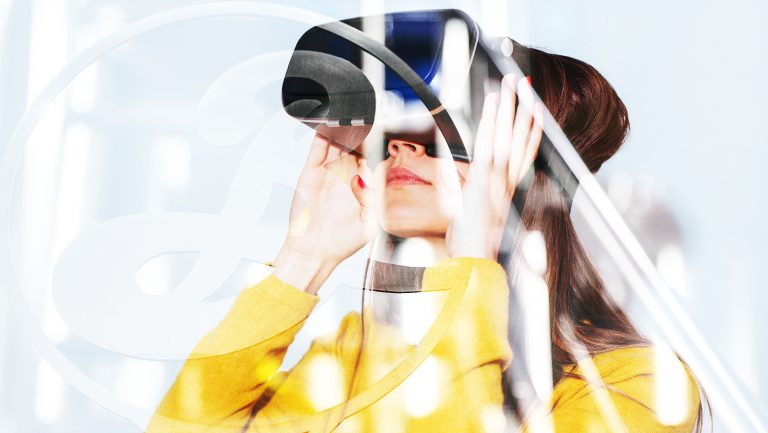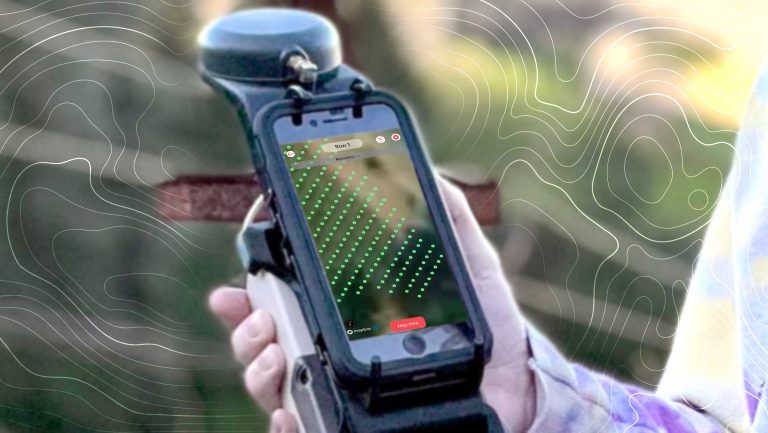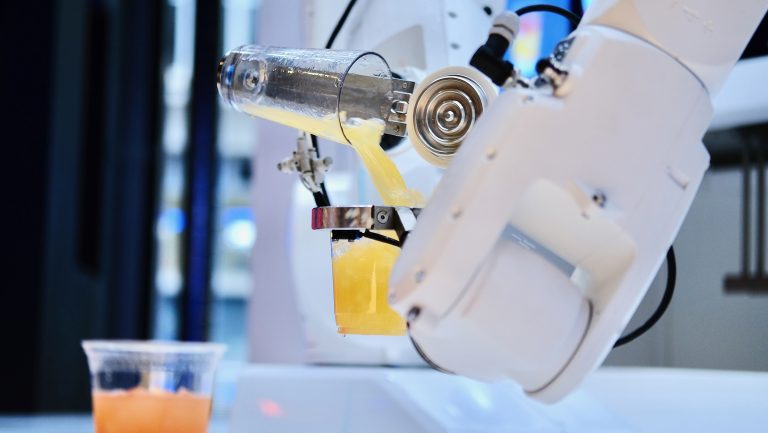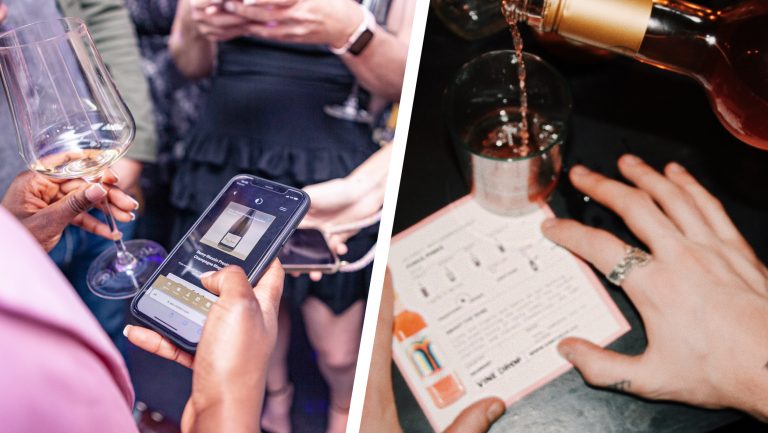Brooklyn Brewery’s brewmaster, Garrett Oliver, has one of the most recognizable voices in beer. You don’t hear impressions à la Christopher Walken or Robert De Niro, but just as Morgan Freeman nails the narration of nature films, Oliver’s empyrean tone and diction are a perfect fit for virtual reality, or VR.
So when you hear him say “Welcome to my lair” in a menacing voice, even without seeing him you feel his presence and you’re not sure what to expect. Next thing you know, he’s ushering you into his brewhouse—the VR version. Once past the shiny mash and lauter tuns, Oliver walks you through the cellar and into what he calls the Barrel Library—a room filled with oak casks aging all manner of strong and delicious beers—and then he says, “I wish we had Smell-O-Vision because this place smells great.”
A moment later, Oliver directs your attention to a chandelier that was hung in the bottling room during a birthday party, a detail most likely unnoticed on the actual-reality tours conducted by actual guides.

Don’t miss the latest drinks industry news and insights. Sign up for our award-winning newsletters and get insider intel, resources, and trends delivered to your inbox every week.
The first time I visited the Brooklyn Brewery was in 2006. The second time was in VR. I confess I didn’t like it as much the second time around because I didn’t get to drink any beer. Oculus Rift and HTC Vive VR headsets may deliver a lifelike audiovisual brewery tour experience, but they haven’t yet figured out how to let you smell or taste the product.
Even with such limitations, though, VR is a growing industry. Goldman Sachs Global Investment Research reports that by 2025, VR software will generate some $35 billion between consumer-facing and business-to-business revenue, while hardware will account for another $45 billion.
Brooklyn Brewery’s marketing manager, Samantha Bernstein, explains that people who are into craft beer aren’t necessarily just out to grab a beer. “A lot of them are interested in hearing the stories [about the beer],” she says. “We welcome thousands of people here each week, but when folks can’t get to the brewery, how do they experience our brand, our world?”
VR is not only a dynamic storytelling device, it’s a mode that enables people from London to Japan to visit the Brooklyn Brewery—and numerous other breweries, distilleries, and wineries—without having to leave home. And good luck getting Oliver to conduct your tour IRL (in real life).
The cost to rent and set up the equipment needed to produce a VR experience can range from $200 to $500,000, depending on the quality of the equipment you use, says Colin West, executive producer and director of WINERAM Productions, a company based in Sonoma, California, that specializes in video production (including VR) and public relations for the wine industry. Production and editing costs, he says, will also vary according to a number of considerations, including whether you’re going for a prepackaged production or a customizable, dynamic presentation. A growing number of drinks industry brands are now making the investment and testing out this enhanced mode of immersive storytelling.
The Jack Daniel’s Distillery is another that offers a VR experience as one of its distillery tour options. In late 2015, Jack Daniel’s approached the FCB Agency in Chicago to develop the VR version of the tour; the distillery then worked with a production company called The Mill to create the tour. The Jack Daniel’s VR tour has been viewed over a quarter million times on YouTube and nearly three million times on Facebook.
I visited the distillery in Lynchburg in 1996—and again a few days ago, for this article, from my living room. It was as if I was right back in that tiny town where all that Tennessee whiskey comes from. I heard the trickling water from Cave Spring, almost smelled sugar maple scorching into charcoal, and watched coopers making barrels as sparks seemingly flew right past me. Only this time as I shuffled through a rickhouse, creepy holographic people appeared on aging casks. Holograms aside, it was just like being there.
Jesus Ostos, senior Jack Daniel’s brand manager, says that VR has the ability to offer consumers memorable experiences. “Even though it’s not a specific tangible, [VR] helps us connect positively [with consumers]…in a fun and simple way,” he says. “Technology is a key element of consumers’ lives. We believe more unique, technology-based experiences will be available in the near future.”
Visiting Media, based in Portland, Oregon, took the idea of a VR winery tour, with 360-degree video, and expanded on it, developing a multipurpose presentation for Paso Robles Wineries, an organization that promotes hospitality in this California wine region. “What we are offering is not just a VR tour,” says Lauren Lekai, founder and principal owner of Paso Robles Wineries. “It’s a digital brochure.” Lekai explains that the Paso Robles Wineries brochure—no trifolds here—contains all the information that can sit on a company’s website or be texted to anyone’s phone in just one digital entity.
“The wine industry tends, especially in PR, to be a little behind the times,” she says. With the VR brochure, not only can someone take a virtual tour of myriad wineries, hotels, or restaurants in the Paso Robles area, but when they encounter an icon, they can click to see (or buy) more. Says Lekai, “People are then able to immerse themselves from their cell phone.” You don’t even need a $500 Oculus Rift; for about $15, you can slip your pocket tech into a cheap, analog Google Cardboard.
Is a PR campaign like hers effective? Lekai says that it “hasn’t become as mainstream as perhaps all of the big industries would’ve liked it to, but Facebook has invested something like $3 billion in VR [and augmented reality, or AR]; it’s on the horizon. It’s so much more immersive than just seeing photographs. If a picture’s worth a thousand words, how much is an immersive video experience worth?”
Perhaps VR doesn’t think so much outside the box as all the way around it. Jeannette Heindel, an executive producer at the video production company Impossible Engine, (which has offices in Bend, Oregon, and in Austin, Texas, describes a moment last year when “VR was gaining buzz.” Because fellow Oregon company Deschutes Brewery’s beer names and labels depict real places in Bend, Heindel says it seemed like a natural fit for both the VR technology and the virtual experience. “Knowing Deschutes plans to open a brewery in Virginia, we thought it made sense to solidify their introduction to a new region by taking their existing—and new—customers to the actual places on those beer labels,” she says. “You can sip a Black Butte Porter while (virtually) hiking up Black Butte.”
I’d been invited to Impossible Engine’s office to check out its VR videos for Deschutes. I’ve hiked around Bend IRL, and the VR version tapped into that cranny of my brain. Yet I couldn’t overlook the fact that my feet weren’t moving. Worse still, I couldn’t smell Douglas firs and Ponderosa pines. It’s those details that keep VR from being fully immersive.
“My only disappointment,” laments Heindel, “is my inability to get the scent of the hops on site when the viewer is experiencing Hop Trip. Maybe as the AR technology develops!”

Dispatch
Sign up for our award-winning newsletter
Don’t miss the latest drinks industry news and insights—delivered to your inbox every week.
Brian Yaeger is the author of Red, White, and Brew and Oregon Breweries. A Cicerone Certified Beer Server since 2009, he contributed to The Oxford Companion to Beer and writes for several industry publications. He earned a Master of Professional Writing degree (with a thesis on beer) in 2007 from the University of Southern California.







